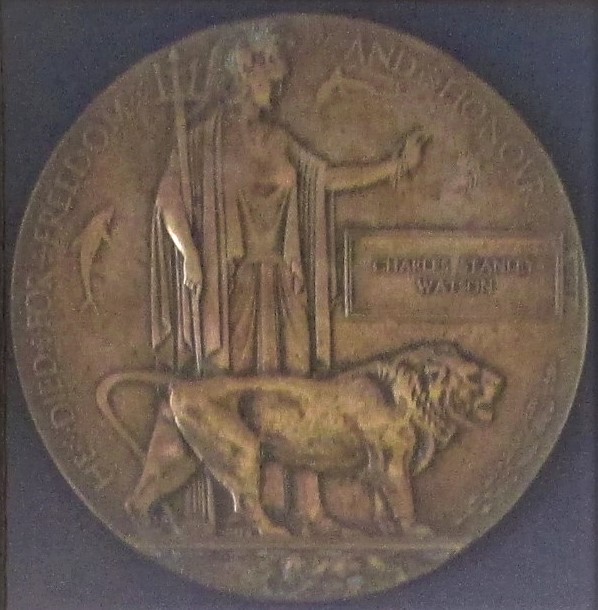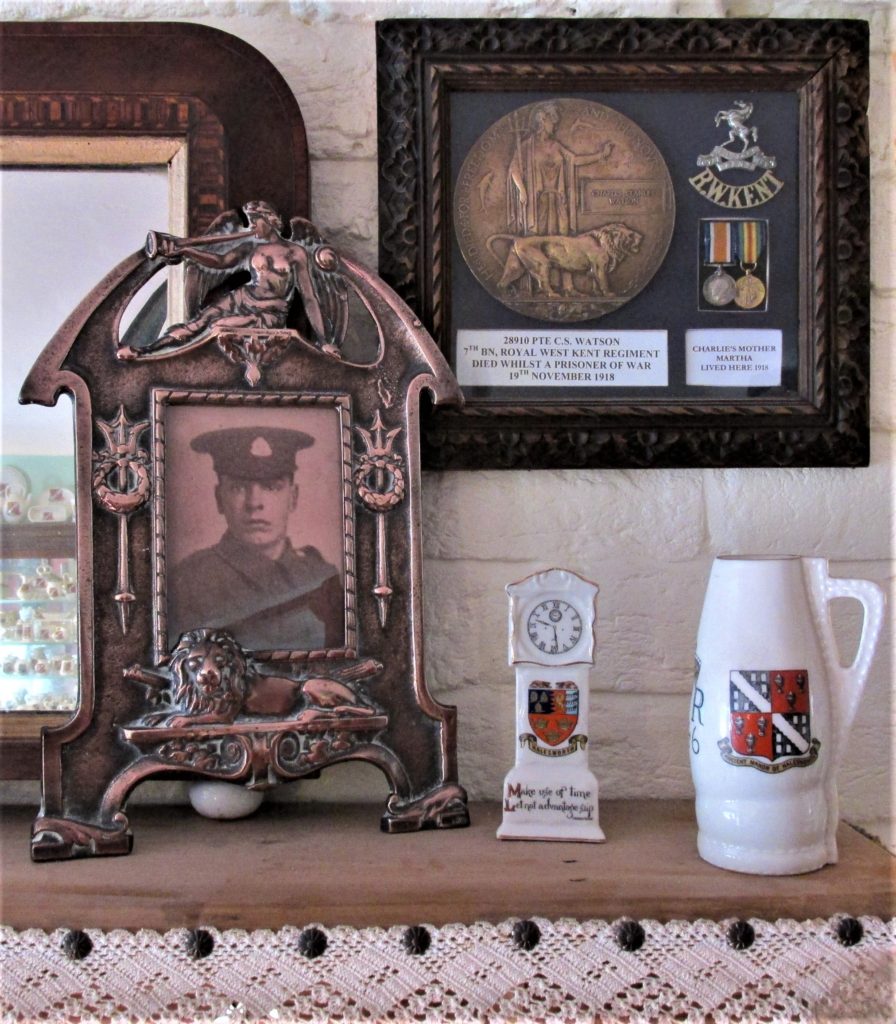28910 PRIVATE CHARLES STANLEY WATSON
7TH (SERVICE) BATTALION
ROYAL WEST KENT REGIMENT
DIED OF INFLUENZA
19TH NOVEMBER 1918
AGE 17 YEARS
The last of the Halesworth residents to lose two sons during the Great War was widow Martha Watson (née Lankester) who had originally hailed from the north Suffolk port of Lowestoft. She married her son’s father John, in the town of Halesworth during the first quarter of 1893. At the time of their wedding, her husband had, over the previous weeks, been discharged from the regular army after twelve years of service (see his story below). At the time of the 1901 census their family consisted of five children, although the youngest, a daughter Florence, would die shortly after, aged three months. While the family were living at 79, London Road, another daughter, Isabella, aged seven, was to be found living with her grandparents in Chediston Street. On the census John’s occupation was listed as that of a nightwatchman and scavenger, employed by the town council. The younger of her two sons to give his life was Charles Stanley, known as Charley, who was born in the fourth quarter of 1900. Very little information with regard to his early life has been found, other than that his father John had died at the comparatively young age of forty-seven years during the first quarter of 1909. This left Martha, with seven children to care for, in dire circumstances. In those days, long before the introduction of the Welfare State, her only course of action was to present herself and children, including Charley now aged twelve years, into the care of the Guardians of the Blything Union, who admitted them into the Union Workhouse located at nearby Blythburgh. At the time of the 1911 census they were all living as inmates. How long they remained under the care of the Blything Union is not known but possibly, as the older children became able to find work, they would have helped to pay for a modest family home. In the Gales Almanack for 1913 there is a Mrs Watson living in a cottage at 133, Chediston Street.
At the outbreak of war in August 1914, Martha’s three eldest sons were still too young to serve in the armed forces. This did not appear to bother the brothers, possibly due to their tough upbringing in the Workhouse, as all three of them seem to have enlisted underage into the army. As with many other cases of men who lost their lives, information regarding their service can be very difficult to find. In Charley’s case, even after seeing his two elder brothers marching off to war and then hearing later of Edward’s death in 1915 and James suffering gas wounds two years later, it appears he volunteered to serve some time in late 1917 at the age of just seventeen years. When he reported to the barracks at Bury St Edmunds, he no doubt hoped, just like his brothers before him, to go on to serve in his county regiment. Sadly for him, at this stage of the war, new recruits and even men returning after recovering from wounds had been sent to those regiments most in need. A fine example of this would have been one Halesworth Territorial, Lance Corporal William Johnson of Chediston Street who, after having been sent back to England from France in January 1915 suffering from pleurisy, was then posted to join the 18th (Service) Battalion of the Highland Light Infantry which had originally been formed in Glasgow. How William, with his strong Suffolk accent, would have managed to converse with his Scottish comrades can only be wondered at? Although no doubt disappointed not to have been enlisted into the Suffolks, Charley may well have drawn some satisfaction from having been sent to join his father’s old regiment, the Royal West Kents, to serve as a Private soldier with the regimental number of G/28910. On completing his basic training he was sent out to France, probably in the early months of 1918, to join the 7th Battalion of his regiment. This was one of Lord Kitchener’s new army battalions raised at Maidstone, Kent in September 1914. A check of the War Diary of the 7th West Kents shows that during April 1918 the battalion lost over five hundred and seventy other ranks during the period of the German Spring Offensive, which had been launched on 21st March 1918. It would probably have been shortly after these losses that Charley joined the battalion as a casualty replacement. After his arrival and over the following months he and his fellow reinforcements would have settled down to the life of front line infantryman. Further checks of the War Diary shows that during the month of August 1918 the 7th West Kents, now serving in the 18th Eastern Division, had returned to the area of the Somme, where they then became involved in the battle of Amiens, which was fought between the 8th and 9th of that month. This was followed on 28th August by operations in the area around the town of Albert. It was during one of these offensive actions that Charley was made a Prisoner of War. On his capture he had been transported to the Germans’ prisoner of war camp located near the town of Dulman in the state of Westphalia. At this stage of the conflict, with just a few weeks remaining before the Armistice was declared, those men who were now ‘Behind the Wire’ could start to look forward to returning to their homes. Sadly for many, including other men from Halesworth, they had one more battle to face, that of the world pandemic known as the Spanish Flu. It was during the week of Germany’s unconditional surrender that young Charley was admitted to the camp’s hospital suffering from the virus which he would die from on 19th November. As with our previous townsman John Walters, Charley was originally laid to rest in the Dolmen town cemetery before, in 1922, along with John and all the other British dead being reinterred in the Cologne Southern Cemetery. Back home in Halesworth, Martha who had now moved into 76, Chediston Street in the area known as Rumsby’s Yard, could only patiently wait and pray for the safe return of her young son. It was possibly due to the chaos and confusion that was rife in Germany at that time that news of her loss did not reach her until some four months after his death. This was delivered in a letter sent from the Infantry Records Office. The news of Charley’s death at the age of just seventeen years was announced to the people of the town in an article published in the Halesworth Times on the 8th April 1919.
After losing Charley, in September 1919 Martha received the second payment of War Gratuity in respect of her son’s life which amounted to a total sum of £16.14s.1d (£16.07p). Also found in the National Archive pension records for the dependents of those who lost their lives during the Great War, there are three separate entries relating to Martha and the loss of her two sons, but there is no sign of a pension being granted.
As well as the financial award, Charley’s mother, having been nominated as his next of kin would have been entitled to claim his medal awards of the British War and Victory medal pair, with his named bronze memorial plaque and scroll.
Today his framed memorial plaque is proudly displayed with his brother Edward’s framed photograph above the actual fireplace of his mother’s former home at 76, Chediston Street, while the location of his medal pair is unknown.
THE MILITARY SERVICE
OF
JOHN WATSON 1862-1909
Enlisted to serve at the 31st Brigade Depot, Southtown Barracks, Gorleston, Norfolk 22nd February 1881.
Having previously served in the West Suffolk Militia.
After training, posted to join the Queen’s Own Royal West Kent Regiment at Invicta Barracks, Maidstone, Kent to serve as 2536 a Private Soldier.
Sailed for Egypt with his Battalion where he then went onto serve:
Egypt 02.08.1882 – 11.10.1882
Cyprus 12.10.1882 – 03.09.1884
Egypt 04.09.1884 – 09.11.1884
Sudan 10.11.1884 – 31.01.1886
Egypt 01.02.1886 – 16.06.1886
Gibraltar 17.06.1886 – 27.03.1887
England 28.03.1887 – 18.02.1893
19th February 1893 released to the Army Reserve having served twelve years.
During his service he had been awarded the Egypt Medal 1882–1889 with the Nile 1884-1885 clasp and the Khedives Star.
The location of these is unknown.


